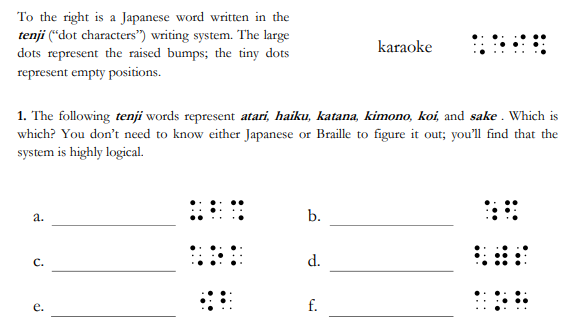
I will post more problems as the easier ones are solved. You may need a pen and paper.

I will post more problems as the easier ones are solved. You may need a pen and paper.

First solved by KrazyKat.
Solved by Nyte. Huber later solved independently and also gets points.
Solved by Huber.
Solved by Huber with contributions/near misses by KrazyKat and Nyte and participation points for Jones.
Solved by Huber.
Solved by Huber with a correction on Part 2 by Nyte.
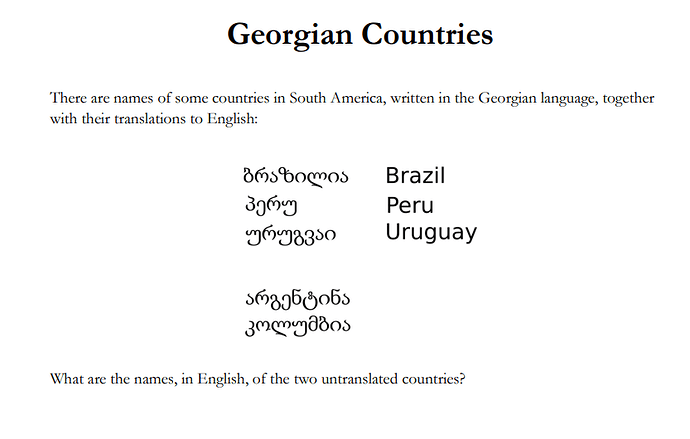
First solved by Huber. Also solved by Nyte.
First solved by Huber. Also solved by Nyte.
This concludes the "Easy" problem set and the thread moves to Phase 2.
Solved by Huber with a half-assed attempt by big_ass.
Solved by Huber. Significant attempts by Nyte and big_ass.
Solved by Huber.
Solved by KrazyKat and big_ass.
Corrected and then solved by KrazyKat - there is an error in the sample on lines 7/8. Also solved by big_ass.
Solved by Huber with a decent attempt by big_ass.
Semi-solved by Nyte and big_ass. If anyone solves fully he can get extra points.
Icelandic Kinship rolls over.
The first spoiler will contain a hint, the second (inner spoiler) a full explanation.
I noticed first that the number of "blocks" is roughly equivalent to the number of syllables in the word.
If we write out the separate syllables of "ka ra o ke" above its corresponding tenji, we identify the tenji for "ka" and then have a good suspicion at "katana," "sake," and also can start to draw conclusions about which of the unmatched tenji corresponds to the given words based on number of syllables. Note: This only works with the assumption "i" in "koi" and "haiku" is its own syllable.
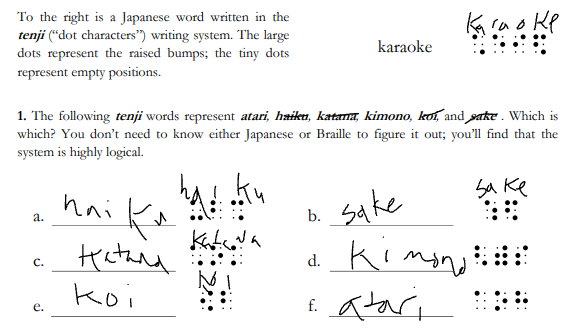
From here it is basically an algebra problem.
To write the new words we have to decipher the tenji language beyond basic syllables.
To do so, we can look at the differences between similar syllables such as "NA" vs "NO" or "KA" vs "KI" vs "KO"
When we do this, we notice the top left 3 dots match when the vowels are consistent and the bottom 3 match the consonants.
Using this rule, we can create a rough alphabet of the phonetic characters in the sample.
From there, we can make assumptions about new tenji such as Ni, Mu, and So.
(This is probably vaguely incorrect from an actual tenji understanding perspective but since it is a phonetic alphabet we can roughly correlate it to the not-quite-phonetic alphabet we are most familiar with.)
For more on tenji: Japanese Braille - Wikipedia
At first this felt like some intuitive linguistics puzzle, like we need to suss out what words are good or bad. But no - it's simply algebra.
TBD. Ancient Greek was a doozy.
Try to map out the different rules - which part of the word dictates how it will be pluralized?
This one was maybe the most simple to me - if the word ends in a vowel, add an "S". Ending of "T" becomes "TZ." "L" becomes "LS" and "X" becomes "XES." We can quickly check that other factors don't change this rule (eg. "OT" and "ET" both become "ETZ") but there's no trick.
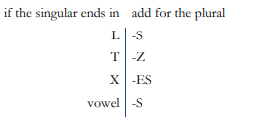
The final sample statement is the significant one.
This felt a bit cheap to me. Technically, by the given samples, we can assume "pain-e" and "zir-e" are synonyms meaning "under." We can treat them as such and translate everything directly. (Use "under" for both in Part 1 and use them interchangeably in Part 2.)
However, the problem is asking us to recognize a distinction here between "under" as in "covered by" and "under" as in "at the foot of."
In this case, the correct answer of Part 1 asks us to recognize that a) The stool is at the foot of or beside the table, and b) The book is under the bookcase.
For Part 2, the problem wants us to identify that both translations are valid in both statements. I'll include the explanation unaltered here:
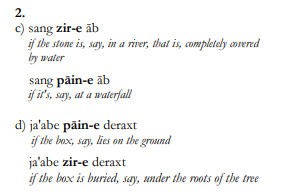
The trick here is in the first sample word.
The first word is translated as "Brazilia." From there, it is 1:1 with the characters to our own spelling. We can fill in the characters we know to then guess the words "Argentina" and "Columbia."
Identify repeated words our syllables in the sample and match them to repeated words in the English phrases.
Hint: Split the words into syllables, like in the Tenji problem, and look for repetition to identify meanings.
Promotion Rules:
Full solution:
Hint: Try to count digits starting from 1. At what point does the writing system change? Can the writing system "batch" numbers in some way?
It's a base-20 system with sub-base 5. Numbers 1 thru 4 are counted in the vertical W slashes, multiples of 5 in the horizontal W slashes above the vertical W, and multiples of 20 counted as a new column/digit like our multiples of 10 in our number system.
The swirly thing is a 0 and the rest is just algebra.
The hard problems have a trick to them. This one has a cool trick. Find the obvious answer, then find it is not quite right.
Hint: Look at how many times a word occurs in the samples. What's going on with the connector words?
Hint: Two different words in Basque can have the same meaning in English but differ for contextual reasons.
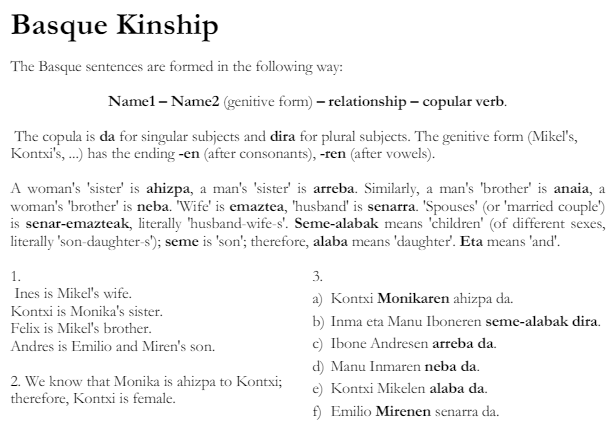
grow up
My IQ is low but it doesnt matter
a. haiku
b. sake
c. katana
d. kimono
e. koi
f. atari
all wrong
I doubt it.
g. karate
h. anus?
KrazyKat has solved the first problem set.
Problem Set 1, Part 1 Explained:
I noticed first that the number of "blocks" is roughly equivalent to the number of syllables in the word. If we write out the separate syllables of "ka ra o ke" above its corresponding tenji, we identify the tenji for "ka" and then have a good suspicion at "katana," "sake," and also can start to draw conclusions about which of the unmatched tenji corresponds to the given words based on number of syllables. Note: This only works with the assumption "i" in "koi" and "haiku" is its own syllable.

From here it is basically an algebra problem.
Solution to Part 2 to follow.
no tfucking funnyy
quit being so blitty
Hate to break it to you but "IQ" being meaningful is an early 2000s phenomena -- post Trump 2024 the only thing that will matter is having the mental fortitude to butcher women and children.
You: I'm going to solve Alightsoul's quirky puzzles xD -- my girlfriend is so random we're learning Japanese together ;3
Me: There's no 'g' sound provided in the "tenji" examples to spell out the n-word.
Proud boys standing down and standing by.
Keep em' comin' alightsoul